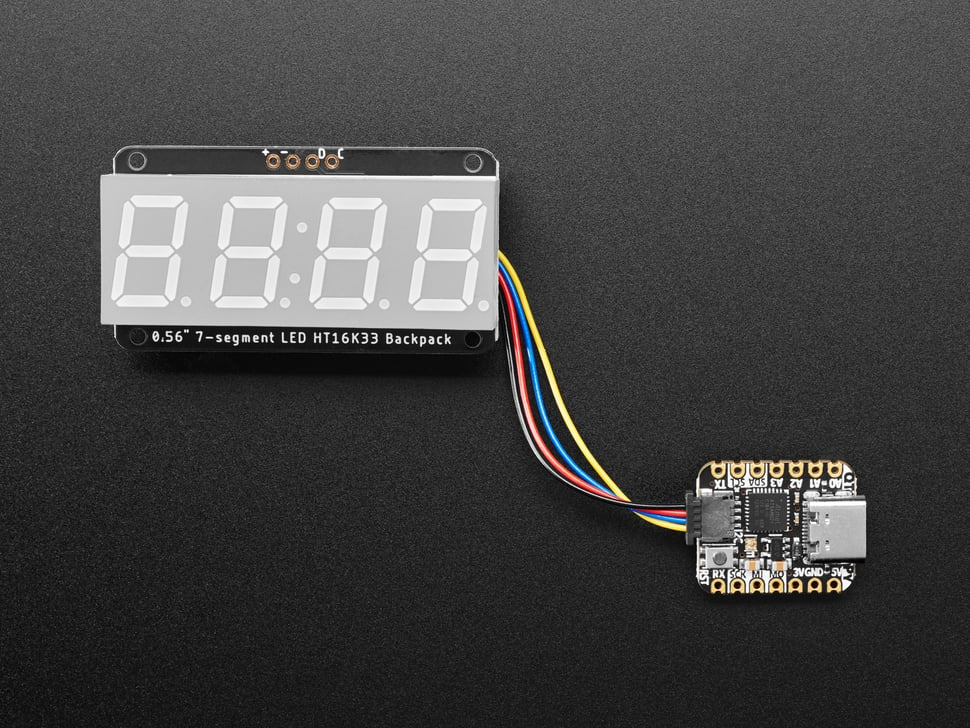How to use 7-Segment LED Backpack
What is a7-Segment LED?LED Backpack?
LEDThis (Light Emitting Diode) is a semiconductor light source that emits light when current flows through it. LED includes two pins, Cathode(-), aka the short leg, and Anode(+), aka the longer leg. It is oneversion of the mostLED common components. Making it lights upbackpack is usuallydesigned for these big bright 7-segment displays. These 7-segment displays normally require 13 pins (5 'characters' and 8 total segments each) This backpack solves the firstannoyance stepof intousing physical13 computingpins but we are going to door a littlebunch bitof morechips thisby time.
Whatan isI2C PWMconstant-current pin?
matrix Pulse-widthcontroller modulationsit (PWM)neatly pins areon the pinsback thatof youthe canPCB. findThe oncontroller yourchip Arduinotakes withcare "~"of everything, drawing all the LEDs in front of it. For example, pin D3, D5, D6, D9, D10 and D11 on Arduino UNO are PWM pins. The Arduino IDE has a built in function “analogWrite()” which can be used to generate a PWM signal. The frequency of this generated signal for most pins will be about 490Hz and we can give the valuebackground. from 0-255 using this function.
analogWrite(0)means a signal of 0% duty cycle.(turns somthing off)analogWrite(127)means a signal of 50% duty cycle.(turns somthing half on, e.g. dimmed light)analogWrite(255)means a signal of 100% duty cycle.(turns somthing on)
It can be used in controlling the brightness of LED, speed control of DC motor, controlling a servo motor or whereAll you have to getdo analogis outputwrite withdata digitalto means.it using the 2-pin I2C interface.
There tutorial,are wethree willaddress use the PWMselect pins so you can select one of 8 addresses to control itup andto have8 itof performthese ison breathinga light.single 2-pin I2C bus (as well as whatever other I2C chips or sensors you like). The seconddriver LEDchip can 'dim' the entire display from 1/16 brightness up to full brightness in this1/16th tutorialsteps. isIt optional.cannot dim individual LEDs, only the entire display at once.

Wiring
Wiring is simple, there are just 24 wires and a resistor.wires.
LED short pin (-)GND to GroundLED long pin (+)VCC toPWM5V- SDA
pinto(D3),SDA - SCL
220ΩtoresistorSCL
Finding i2C address

i2c_scanner example code, which will show the address of the i2c device connecting to Arduino.
Getting started
#define#include led 3 //any PWM pins (~)
#define led2 11 //optional 2nd led
int brightness = 0; // how bright the LED is
int fadeAmount = 5;<Wire.h>
void setup() {
pinMode(led, OUTPUT)Wire.begin();
pinMode(led2,Serial.begin(9600);
OUTPUT)while (!Serial); //optional Leonardo: wait for 2ndSerial ledMonitor
Serial.println("\nI2C Scanner");
}
void loop() {
int nDevices = 0;
Serial.println("Scanning...");
for (byte address = 1; address < 127; ++address) {
// The i2c_scanner uses the return value of
// the Wire.endTransmission to see if
// a device did acknowledge to the address.
Wire.beginTransmission(address);
byte error = Wire.endTransmission();
if (error == 0) {
Serial.print("I2C device found at address 0x");
if (address < 16) {
Serial.print("0");
}
Serial.print(address, HEX);
Serial.println(" !");
++nDevices;
} else if (error == 4) {
Serial.print("Unknown error at address 0x");
if (address < 16) {
Serial.print("0");
}
Serial.println(address, HEX);
}
}
if (nDevices == 0) {
Serial.println("No I2C devices found\n");
} else {
Serial.println("done\n");
}
delay(5000); // Wait 5 seconds for next scan
}
Getting started
This is modified from Adafruit LED Backpack library - sevenseg example.
Make sure to have the correct i2c address.
#include <Wire.h> // Enable this line if using Arduino Uno, Mega, etc.
#include <Adafruit_GFX.h>
#include "Adafruit_LEDBackpack.h"
Adafruit_7segment matrix = Adafruit_7segment();
void setup() {
#ifndef __AVR_ATtiny85__
Serial.begin(9600);
Serial.println("7 Segment Backpack Test");
#endif
//change the address to the one you found in the i2c scanner sketch
matrix.begin(0x73);
}
void loop() {
//breathing lighttry analogWrite(led,to brightness)print a number thats too long
matrix.print(10000, DEC);
analogWrite(led2,matrix.writeDisplay();
brightness)delay(500);
//optional forprint 2nda ledhex brightnessnumber
=matrix.print(0xBEEF, brightnessHEX);
+ fadeAmount;
if (brightness <= 0 || brightness >= 255) {
fadeAmount = -fadeAmount;
}matrix.writeDisplay();
delay(50)500);
//speed ofprint thea pulsingfloating point
matrix.print(12.34);
matrix.writeDisplay();
delay(500);
// print a string message
matrix.print("7SEG");
matrix.writeDisplay();
delay(10000);
// print with print/println
for (uint16_t counter = 0; counter < 9999; counter++) {
matrix.println(counter);
matrix.writeDisplay();
delay(500);
}
}

